Creating new content is costly and resource-intensive. A whopping 65% of marketers agree that repurposing content is more cost-effective than creating new content and 46% of marketers say that repurposing existing content delivers better results than new content.
If you are not repurposing content actively, you are wasting not just content but your resources.
Let’s dive into the world of content repurposing and see how it can change the way you market your brand and connect with your target audience.
What is Content Repurpose?
Content repurposing (also known as content recycling) refers to reusing and republishing existing content in a new format to reach a new audience. The primary purpose of repurposing an existing piece of content is to target a new buyer persona that’s more likely to engage with a certain content format or type.
For example, converting a data-rich blog post into an infographic and then actively sharing and marketing the infographic helps you reach a new target group that’s specifically interested in images and infographics.

There is a whole bunch of new content formats that you can use to reach a wider audience at potentially zero cost (because you don’t have to create new content from scratch).
Why Repurposing Content is Important
Content recycling is an essential part of content marketing as it helps you in several ways as discussed below:

1. More Reach
Content recycling significantly boosts the reach of your content. Your content can catch new eyeballs across different platforms.
Your target audience has different content preferences. One buyer persona might like watching videos while another might prefer reading long-form blog posts. When you repurpose a piece of content and publish it to a new platform, you reach a new target group that you can never reach otherwise.
2. More Traffic
Repurposed content is published on a different platform and as you publish high-quality content on different platforms, you generate referral traffic.
For example, converting an infographic into snippets and then sharing them on social media drives referral traffic to your site. Similarly, distributing an infographic that you created from a series of blog posts on leading image-sharing sites will help you drive heaps of traffic to your website.
3. Higher Engagement
When you consistently provide your ideal customers (across different personas) the exact type of content they need in the format they like improves content engagement.
Repurposing content gives you access to marketing platforms that are more likely to drive engagement such as social media apps. Sharing a blog post link on Facebook might not generate engagement as opposed to when converting that post into a short video or image.
4. New Free Content
Content repurposing keeps your editorial calendar filled. You rarely get out of ideas. Recycled content is usually free and makes it easy to target a new platform without spending any money.
If you decide to use SlideShare to target a buyer persona that uses presentations and spends most of the time on SlideShare or similar sites. You can create slides free of cost from existing content and publish them to SlideShare.
5. Build Authority
When you publish lots of content in your niche and across all the popular platforms, it helps you establish yourself as an authority quickly. You become a leader and expert in your niche.
High content frequency is the backbone of brand authority and thought leadership.
Content Repurpose Best Practices
You should follow proven techniques while repurposing content to ensure it works and doesn’t end up wasting your resources. Here is a list of the best practices to repurpose content successfully:
1. Define Your Goal
Don’t do repurposing for the sake of it. Have a clearly defined goal for every single repurposed content you create and publish.
The goal should define:
- The purpose of content recycling
- What buyer persona to target
- Platform you to use.
Research shows that only 29% of marketers have a well-defined approach to content repurposing which is a big issue:

Defining a goal and an approach for content recycling isn’t a big deal.
Here’s an example of a well-defined goal for content repurposing: To create, publish, and distribute one infographic per month from how-to blog posts to target buyer persona XYZ.
Distribute content repurposing into campaigns and make sure one campaign should have one goal. It’ll keep things simple and manageable.
If, for example, you want to convert the same infographic into multiple images for social sites, you’ll need to create a new campaign with a different goal.
When you have well-defined goals, you can track performance and see how your efforts are paying off.
Don’t complicate content repurposing. Keep it simple and organized.
2. Use Evergreen Content
Content that always stays fresh and relevant for an extended period is known as evergreen content. An article on ‘how to lose belly fat’ is evergreen content while ‘best action movies of 2023’ is seasonal content with declining interest.

You should use evergreen content for repurposing.
Why?
Because user interest and monthly search volume for evergreen topics remain consistent. Repurposing this type of content ensures that your efforts pay off. The idea is that your repurposed content should get found and drive traffic and engagement. This is only possible with evergreen content.
Research shows that evergreen content earns up to 4x more than seasonal content:

You can find evergreen content by looking at the traffic statistics. Content that has had a consistent or upward traffic trend for at least the past year is evergreen.
Here’s an example:

Here are a few rules to follow when finding evergreen content for repurposing:
- Analyze organic traffic trends to individual posts
- Look for content that is at least one year old as it helps you get an idea of seasonal content
- The traffic trend should be consistent (not declining)
- The content should be relevant to your business and must not be too off-topic
- Prioritize blog posts based on their value to your business and traffic potential.
Use the same rules to find evergreen content published on other networks like YouTube.
3. Convert to the Right Format
The biggest problem businesses face when they identify content to repurpose is finding the right format for conversion. You can recycle a single piece of content into numerous formats that it gets overwhelming:

You should use a data-driven approach for the best results.
Just because video content is popular doesn’t mean you should convert all your blog posts into video content. It may or may not work for your brand.
You need to look at buyer personas and analytics.
Ask yourself this basic question: What audience segment (or buyer persona) do we want to reach with repurposed content?
Let buyer personas guide you.
If you have a well-defined goal and you know why you are repurposing a piece of content, you won’t find it hard to identify the right format. Look at the buyer persona and see what content format they like the most.
To help you get started, here’s a list of the top content formats to choose from:
- Video
- Social media content
- Podcasts
- Whitepapers
- Landing pages
- Email series
- Emails and newsletters
- Infographics
- Images, graphics, and charts
- Testimonials
- Case studies
- Reports
- Courses.
4. Use Best Performing Channels
Selecting the right channels for the publication of recycled content is the key to success. Research shows that repurposing existing content for new channels generates the best results for marketers:
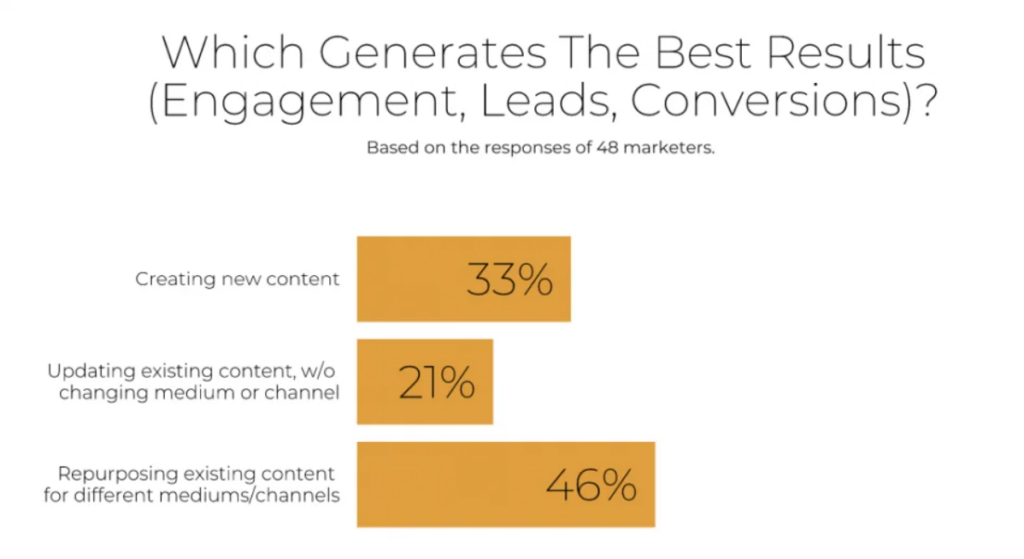
Again, the right channel is one where your target audience hangs out and this could not be one of the leading platforms.
For example, YouTube is the top video streaming platform for videos while Facebook is the most popular social networking site.
But do you have to stick with these top platforms?
No.
You need to choose platforms that work best for your business. This requires finding the right content publication and distribution channels through analytics.
For example, if data shows that you have the highest engagement on X (despite Meta being the leading social platform), you should stick with X, and all your content repurposing campaigns for social media should target X.
If you don’t have enough data or are using new platforms such as presentation sharing sites, use all the popular sites and see which one delivers the best results in terms of traffic and engagement.
Your job is to find the best performing publication and distribution channel for each type of content format you create.
5. Adjust Content According to The New Format
You can convert a blog post into a video or any other format automatically using AI tools. And you can generate transcripts from videos and audios automatically and use them as blog posts.
Changing content format isn’t a big deal, thanks to the bulk of AI tools.
But is this type of content really helpful and something your ideal customers would like to engage with?
Probably not.
Video is reported to be the most effective method of content repurposing followed by social posts. And guess what, some tools automatically generate videos from blog posts such as Fliki or Wideo.

As an example, I took this blog post from Healthline titled ’18 effective tips to lose belly fat (Backed by science)’ and converted it into a video for free via Wideo, here’s a screenshot:

The video uses exact text from the blog post and mentions ‘This blog post provides…”. This type of faceless and non-personalized video might do more harm than good.
I’m not saying that AI tools are bad, how you use them is all that matters.
You should adjust and revise content according to the new platform and this often requires major changes. For example, if you want to convert a blog post into a video, here’s what you should do:
- Decide video format
- Generate a video script from the blog post which should be a rewrite of the existing post
- Remove unnecessary content and stick with the important points
- Record video professionally
- Use advanced equipment and video editing tool.
The same rule should be followed for other types of content repurposing.
Focus on delivering high-quality content to your audience.
6. Update Existing Content
Updating existing content without changing its format is also a form of repurposing especially when it involves a major redo.
For example, if you wrote a blog post on SEO techniques in 2018, it won’t be relevant in 2024. And while you’ll update it today, you’ll require a major redo of the entire blog post – not minor tweaks. This type of content update should be a part of your content repurposing strategy.
Content freshness is also reported to be a Google ranking factor for search queries where users need fresh content. Seasonal content requires major updates regularly and that’s where freshness plays its role in ranking:
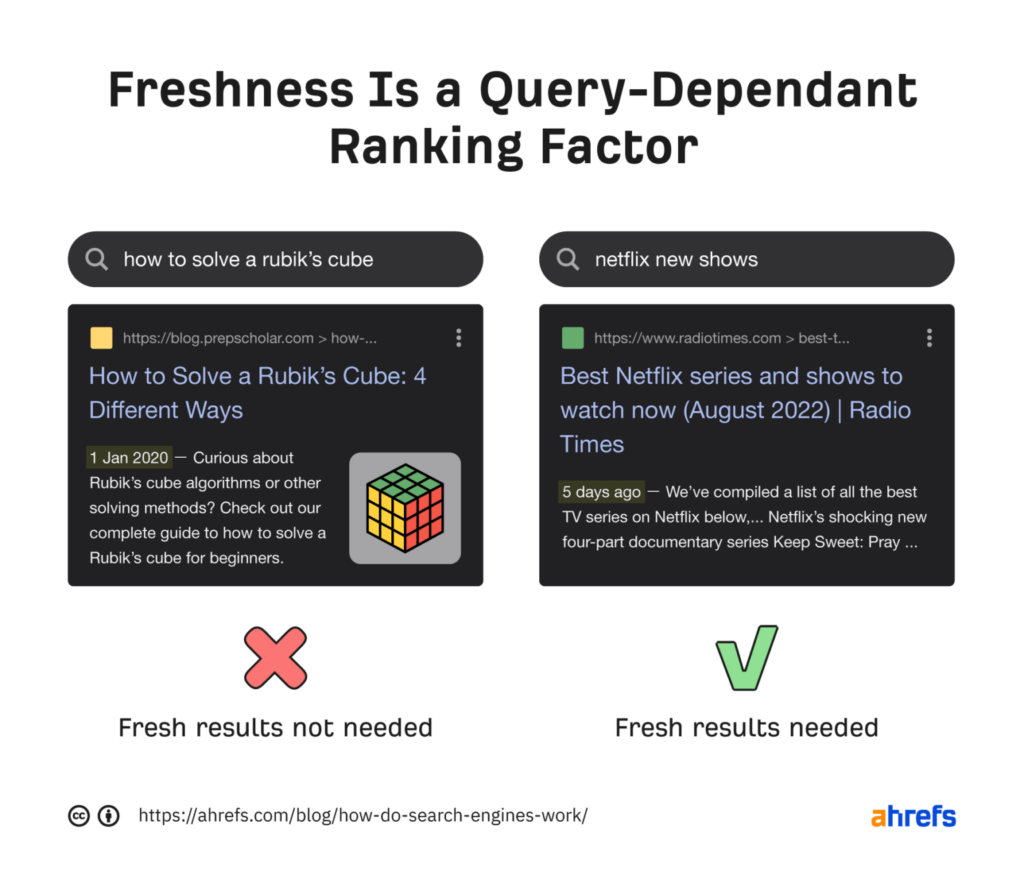
A smart approach is to change the format of evergreen content and republish it on different platforms. For seasonal content, you don’t have to change its format rather update it with new information. It isn’t a nice idea to convert a seasonal blog post into a video or an infographic.
Why?
Because you’ll then have to either update the video and infographic or remove them altogether once they get outdated.
Not a smart move, right?
There are multiple ways to repurpose old content into new content:
- Add more depth and update your content with new information
- Remove outdated sections from the content
- Add images, videos, and links to recent sources
- Change the type of content to address changing reader needs. For example, you can convert a listicle into a how-to guide
- Add new sections in existing content based on analytics.
7. Promote Repurposed Content
A common misconception is that recycled content needs to be published and it’ll drive traffic. That’s not the case, unfortunately.
You need to market repurposed content religiously.
Imagine you convert a long-form blog post into a YouTube video series, and then sit back and wait for people to find it. Instead of the ‘publish and wait’ strategy, you need to switch to the ‘publish and market’ approach.
Promote video series on your blog, social accounts, newsletter, and consider running an ad campaign.
Statistics show that 83% of businesses focus on content quality when producing new content, however, only a few marketers take the extra step to actively promote their high-quality content:
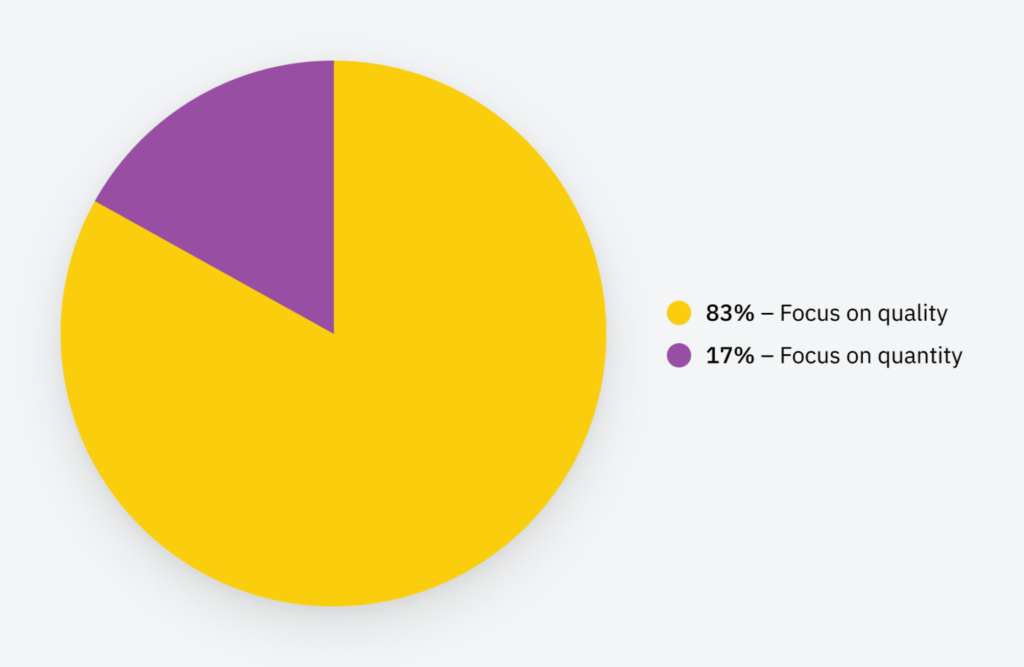
Merely publishing quality content won’t move the needle. Your content, no matter how amazing and top quality it is, will get lost out there if you don’t promote it. You have to share it with the right people to get the most out of your repurposed content.
If you are looking for organic traffic, you need to generate relevant signals for search crawlers so they give importance and due value to your content. Search engines like Google determine the popularity of a piece of content mainly through backlinks (number of referring domains).
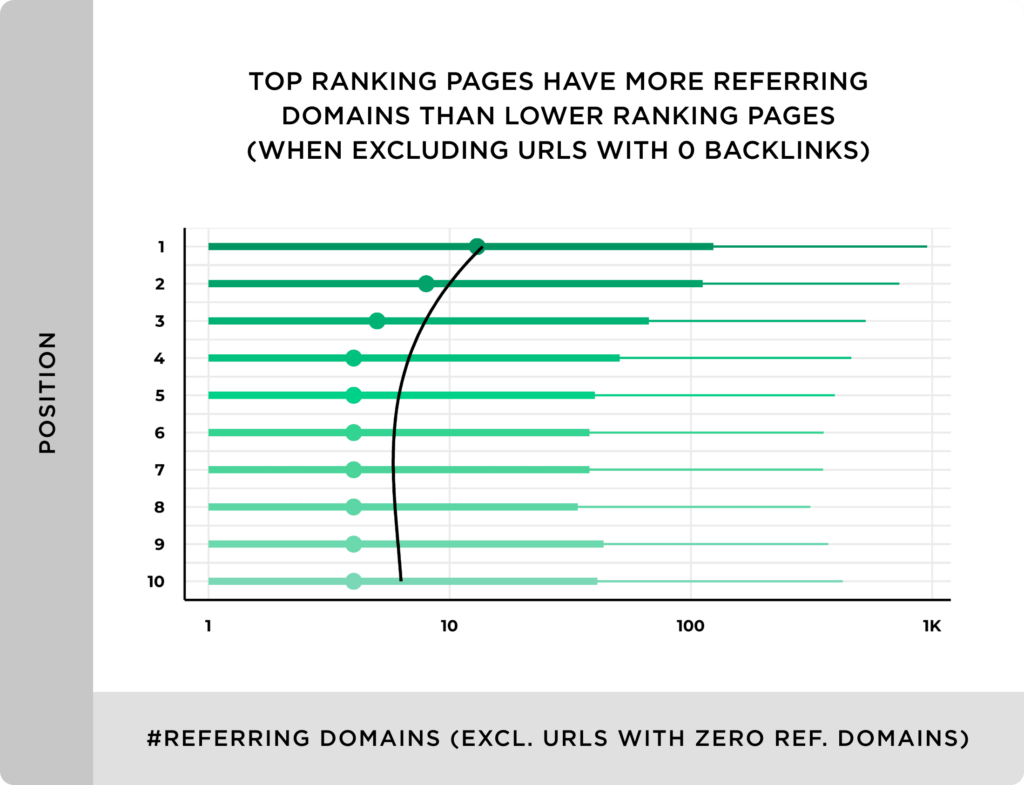
Other factors are secondary.
So, you have to acquire backlinks for repurposed content by linking it from your website and other relevant sites.
Here are some of the best ways to promote repurposed content:
- Share it on social media accounts
- Send its link to your subscribers via an email campaign
- Add a link in the original content
- Create a dedicated marketing campaign to promote newly published content
- Run a PPC campaign for rigorous marketing for certain types of recycled content such as video services, whitepapers, case studies, blog posts, etc.
Content Repurposing Ideas
There are numerous ways to repurpose content to reach new audiences and grow your business. The following list will help you get new ideas to repurpose content:
1. Repurpose Data-Rich Content into Social Media Content
Reports, case studies, and other forms of data-rich content work best on social media. However, it is hard to share a detailed, data-driven report on social media as it won’t get any attention.
You can extract the main points from your report and convert them into images, videos, charts, graphs, and quotes for social media.
Wyzowl publishes a State of the Video Marketing report every year that’s a pretty data-rich survey with lots of statistics, figures, charts, graphs, and more. It then creates short images of the report and shares them on its Instagram account:
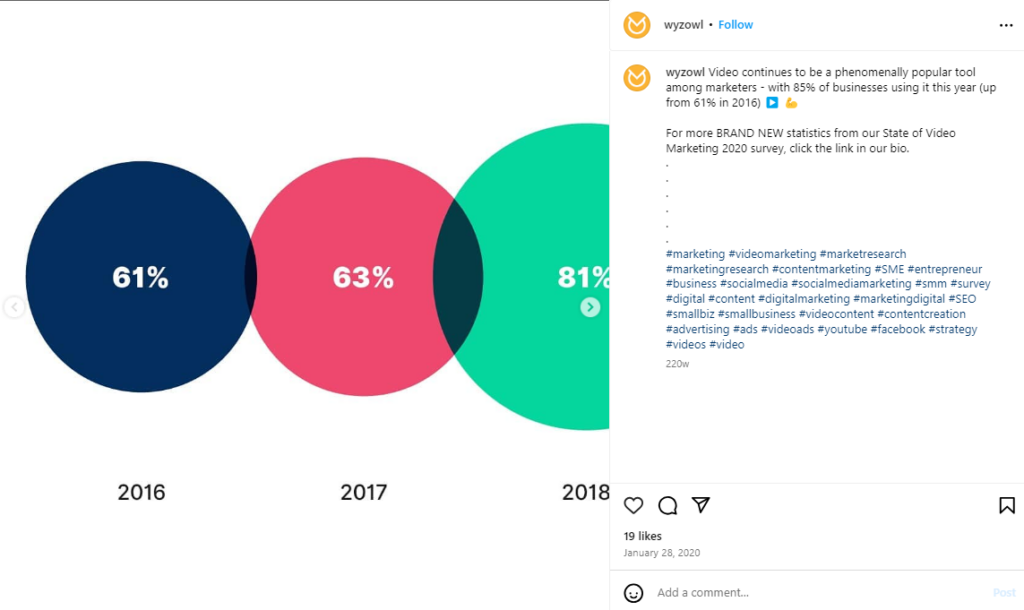
You won’t find a lot of likes to this post and that’s because Instagram users aren’t mostly interested in data posts like these. This is why choosing the right platform is essential.
But the way Wyzowl repurposes content is exemplary.
2. Blog Post into X Thread
Threads on X get a lot of engagement as they deliver high-value content to the users. But creating a long, meaningful, and interesting thread isn’t a piece of cake. It requires a lot of resources to come up with a thread that people will like.
You can convert your blog posts into threads and save resources.
What most businesses do is that they simply share a link to their recent blog post on X. That’s an ineffective approach.
Here’s what you should do:
- Repurpose your blog post and create a short blog post that only covers the key findings and major points
- Share it as a thread on X with or without any link to the original post.
Here’s an example from Buffer that often shares its blog posts as threads on X with a link to the post:

It requires a redo of the post and that’s where most businesses struggle. You should embed threads into your editorial calendar (if they work best for your business) so that your writing team creates a thread for every post.
3. Podcast into Blog Posts
Most businesses think of repurposing blog content into other formats while very few think (and do) vice versa. Social Media Examiner has been publishing its podcasts as blog posts for years.
Here’s a recent example of a podcast:
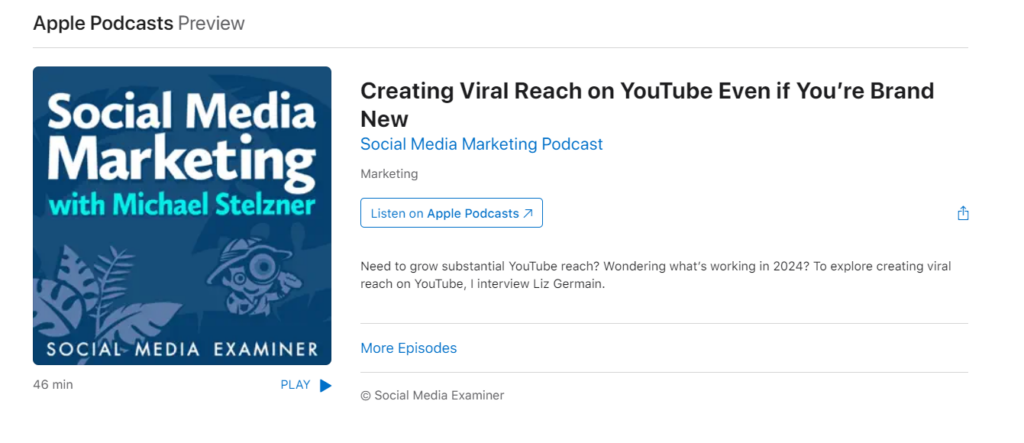
And here’s the blog post they repurposed and published from this podcast:

If you look at the blog post, it is not some AI-generated transcription of the podcast. Rather, it is a well-crafted and quality blog post that is a complete redo of the podcast.
This is a great example of content repurposing where you need to put some extra effort into transforming your content so it’s suitable for the new platform.
You can use this same approach for video content too as most businesses produce audio and video content in bulk as they are in high demand but fail to get maximum value from their efforts.
When you have successfully created a podcast or video, transforming it into an original blog post requires less effort and resources.
4. Long Video into Short Videos
Interest in short videos is growing rapidly due to Reels and Shorts on Meta and YouTube. A study reported that 73% of people prefer watching short-form videos to learn more about a product and 81% of people want to see more short videos from brands in 2024.
Consequently, short videos have the highest ROI when compared to other forms of marketing.
Long videos, on the other hand, have an equally high demand. Around 16% of viewers watched 60-minute-long videos all the way primarily because these videos are more educational and highly engaging. This is a reason why longer videos have a higher conversion rate that goes as high as 13% for videos that are 60-minutes or more:

Since creating longer videos requires more resources, most businesses stick with shorter videos:

This means more businesses producing short-form videos that can’t be converted into long-form videos. In fact, a short video that’s less than a minute can be hardly repurposed into any other form of content. That’s a waste of resources because short videos put a block to repurpose.
You spend all the resources to create hundreds of short-form videos but you can’t repurpose them.
On the flip side, you should create long-form video content and then convert it into short videos and other content formats like blog posts, newsletters, etc.
It makes more sense to spend resources on creating long-form videos (as they keep the loop open for repurposing) and then generate short videos with minimal effort.
Cleo Abram uses this approach. She creates short videos for her Instagram account from YouTube videos that are mostly over 10 minutes. She then posts short videos as Reels on Instagram:
Here’s an example:

This is where she publishes long-form videos:
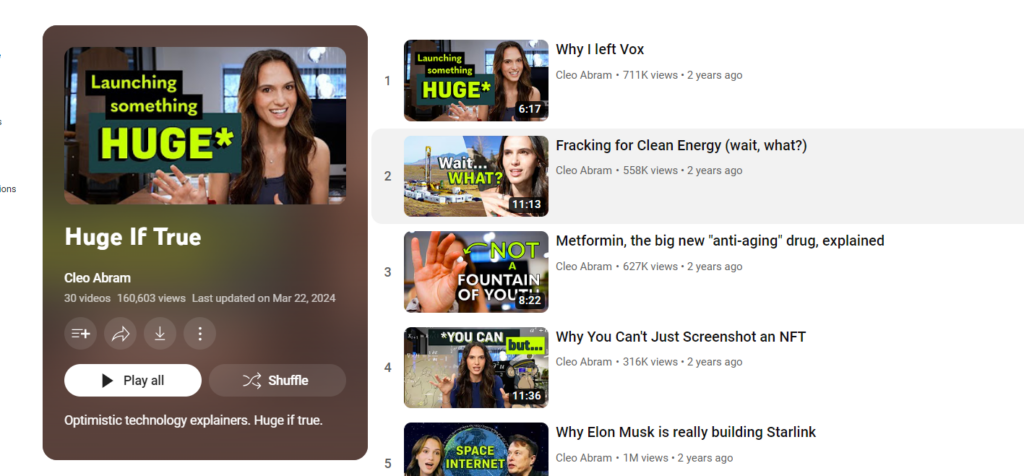
Not bad especially when you look at the likes on her Reel in 2 days. That’s optimized use of resources.
Do the same by channeling your resources smartly and producing content that can be repurposed easily.
5. User-Generated Content into Social Media Images
User-generated content is the best content your brand generates, don’t waste it.
It is common for brands to share customer reviews as posts on social media, here’s an example:

But that’s not enough.
You can do a lot with UGC, here are a few examples:
- Use UGC content in an ad
- Highlight major comments from users and customers about your products and brand in a newsletter
- Cover UGC in a blog post
- Add them to video and audio content.
User-generated content works really well for conversion due to social proof.
Make sure you get consent from the original author before reusing content in any form.
Conclusion
The basic rule of content repurposing is to regularly create content that can be recycled easily. This optimizes your resources and you don’t end up in a place where you don’t have any piece of content to repurpose.
When you create a new piece of content, ask yourself: Can you repurpose and reuse it later?
If you can, go for it.
If you can’t, ask yourself: Is it worth investing resources into a piece of content that can’t be recycled?
Sure, you can invest in non-recyclable content as you always need content to meet the strategic goals of your business and there’ll always be some content that can’t be repurposed.
But having a lot of it or all of it is a big problem.
Content repurposing is a powerful strategy to grow your brand exponentially. Make it a part of your marketing and content strategies.
Featured Image: Pexels



